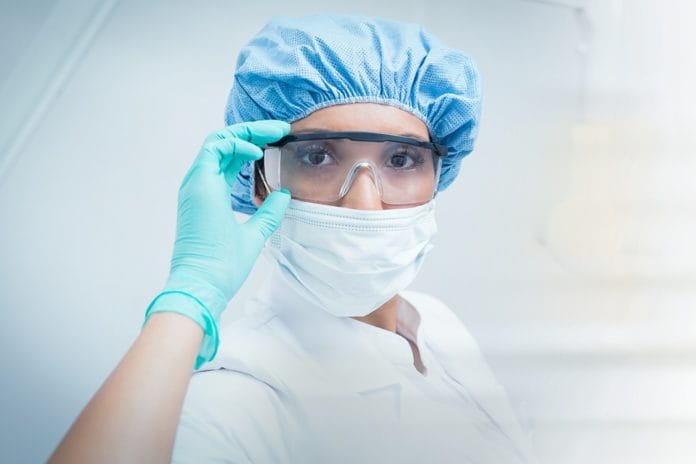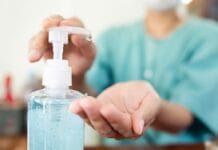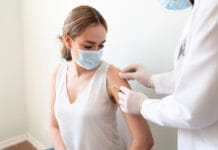We do a lot to ensure our patients are protected while in the dental office. From infection control, safe work practices, and HIPAA compliance, we work very hard to protect our patients. However, when it comes to our own safety, we may tend to compromise. While focusing on the importance of protection for patients, we often forget that our own protection is just as important.
How can we take care of others if we are not taking care of ourselves?
Below are four common ways hygienists can compromise protection.
1) Standing in the Room During Radiograph Exposure
In hygiene school, the fear of radiation exposure terrified us (or maybe the fear of our professors catching us exposing ourselves). In our daily work life, the practice of taking radiographs has become so routine that we often forget the risk of radiation exposure that comes from not following correct exposure guidelines.
Perhaps it is because we are in a hurry or cannot figure out how to get the correct shot without holding the sensor. However, any operator exposure is too much exposure. Although we know that dental radiation is relatively low, ALARA still stands for radiation exposure “as low as reasonably achievable.” This principle applies to professionals too.4
2) OSHA-compliant Laundering
By now, we are all familiar with OSHA’s regulation regarding employers providing dental hygienists with lab jackets. Those lab jackets are not to be taken home by said dental hygienists for laundering or any other purpose.
However, more than half of the hygienists that I have spoken to state this is not a practice in their offices. Many hygienists admit to wearing their lab jackets home or being responsible for laundering them themselves. Why are we so reluctant to ensuring that our offices are OSHA compliant?
A handful of hygienists I have spoken with report their offices only allow them to wear their scrubs while in the building. Thinking of this, the realization of just how much we are potentially bringing home makes me cringe. The change starts with a conversation; sitting down with your employer and working together to bring a change to ensure you are OSHA compliant and protected.2
3) Airway Protection
Since starting my career, I have worked in a handful of offices. Of these offices, not one provided their hygienists or other clinicians with ASTM level three masks. The concept still perplexes me; why would we want to be under protected?
A quick scan of the differences between the mask levels boxes shows that it is recommended providers wear level three masks when using anything that produces aerosols. Since ultrasonic scalers, air polishing, and even the air/water syringe produce aerosols, hygienists should make sure we are taking precautions to ensure that we are protecting our airways.
In March 2018, the Centers for Disease Control and Prevention (CDC) reported on a cluster of dental professionals in Virginia with lung disease. The CDC described a possible linkage between dental professionals’ occupational exposure and lung disease. The CDC stated a need for further research into dental occupational exposures. With the limited information that we have on our risk of occupational exposures, it is important that hygienists protect themselves.1
4) Proper Protection During Sterilization
Our time between patients is typically the most rushed five minutes of an appointed hour. This coveted time is split between flipping the room, running to the restroom, and working on sterilization. It is easy to see how proper clinician protection in sterilization is often overlooked.
Proper eye protection and the use of the correct protective gloves is necessary to prevent an accident. When not wearing the recommended protective gloves, we risk having an instrument stick and possible disease exposure. The chemicals used in differing sterilization baths can cause permanent harm if an accidental splash to the eye occurs.3
Protection is not a foreign concept for dental hygienists. Every day, we make considerable efforts to ensure our patients are protected from a multitude of risks. But are we doing the same for ourselves? If you found yourself or your office guilty of these common compromises to clinician protection, ask yourself: Is it worth the risk?
Check out the Today’s RDH Dental Hygiene Podcast!
References
- Dental Personnel Treated for Idiopathic Pulmonary Fibrosis at a Tertiary Care Center – Virginia, 2000–2015 | MMWR. (n.d.). Retrieved from https://www.cdc.gov/mmwr/volumes/67/wr/mm6709a2.htm
- 1910.1030 – Bloodborne Pathogens. United States Department of Labor. Occupational Safety and Health Administration (n.d.). Retrieved from https://www.osha.gov/laws-regs/regulations/standardnumber/1910/1910.1030
- Frequently Asked Questions – Sterilization – Cleaning. Centers for Disease Control and Prevention. (2013, July 10). Retrieved from https://www.cdc.gov/oralhealth/infectioncontrol/faq/sterilization_cleaning.htm
- Centers for Disease Control and Prevention. ALARA – As Low As Reasonably Achievable. Retrieved from https://www.cdc.gov/nceh/radiation/alara.html












